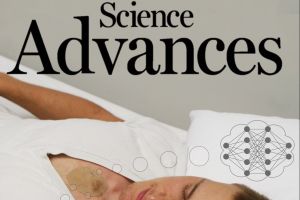Obstructive sleep apnea (OSA) affects over 900 million adults globally, and around eighty percent of cases remain undiagnosed. This critical failure leaves millions of people at an increased risk for serious health complications, like hypertension, obesity, diabetes, and cardiac irregularities. Current diagnostic techniques are fundamentally limited by low throughputs, in the case of polysomnography, and high failure rates, in the case of home sleep tests. Here, we report a wireless, fully integrated, soft sternal patch with mechanics optimized to detect the mechanical, electrical, and optical signals that characterize the cardiovascular response to OSA. Analytical and computational studies in mechanics and material interfaces yielded a fully integrated, multi-sensor system capable of capturing ultrafine, low-frequency, sternal vibrations caused by the heart's motion, cardiac electrical signals, and optical measurements of arterial blood oxygenation from a single location on the sternum, which has not been previously realized. Advanced digital signal processing and machine learning techniques are used to detect apneas and characterize each event's acute cardiovascular consequences. In trials with symptomatic and control subjects conducted in their homes, the soft device demonstrates excellent ability to detect blood-oxygen saturation, respiratory effort, respiration rate, heart rate, cardiac pre-ejection period and ejection timing, aortic opening mechanics, heart rate variability, and sleep staging, making it the first single patch capable of capturing all the clinically essential metrics for OSA diagnosis recommended by the American Academy of Sleep Medicine. Finally, these metrics are used to autodetect apneas and hypopneas with 100% sensitivity and 95% precision with symptomatic patients compared to data scored by professionally certified sleep clinicians.
Soft Sternal Patch to Detect Sleep Stages and Sleep Apnea
Faculty:
Woonhong Yeo
Students:
Nathan Zavanelli
Lab:
Director:
W. Hong Yeo
External Lab Website:
- Flickr
- YouTube
Georgia Tech Resources
Visitor Resources

Georgia Institute of Technology
North Avenue, Atlanta, GA 30332
404.894.2000


